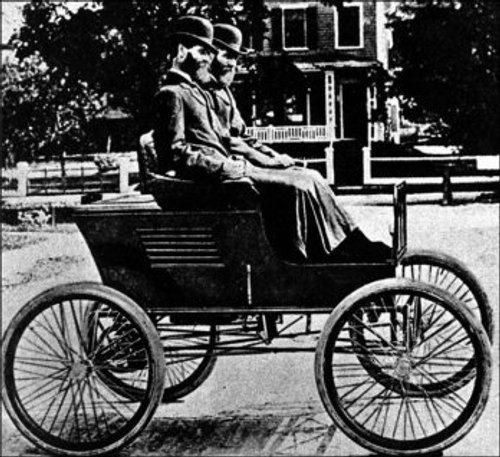William McKinley, the 25th President of the United States, is often remembered for his role in the Spanish-American War, his commitment to American economic prosperity, and his tragic assassination. However, one of the lesser-known but equally fascinating aspects of his presidency is that he was the first sitting U.S. President to ride in an automobile. This milestone event not only highlights McKinley’s embrace of technological advancements but also reflects the broader industrial and social transformations occurring in America at the turn of the 20th century.
The Dawn of the Automobile Era
The late 19th and early 20th centuries were a period of rapid technological innovation. The automobile, a nascent invention during McKinley’s time, was beginning to capture the imagination of the public and industry leaders alike. The introduction of the automobile promised to revolutionize transportation, making it faster, more reliable, and more accessible.
The first practical automobiles were developed in the 1880s and 1890s, with inventors like Karl Benz and Gottlieb Daimler in Germany, and Charles and Frank Duryea in the United States, leading the charge. By the turn of the century, automobiles were still a novelty, primarily owned by the wealthy and used for short, leisurely trips rather than practical transportation.
McKinley’s Encounter with the Automobile
President McKinley’s foray into the world of automobiles occurred on July 13, 1901. He was visiting the Pan-American Exposition in Buffalo, New York, a world’s fair showcasing the latest innovations and achievements of the time. The exposition itself was a symbol of the era’s technological optimism, featuring electric lighting, wireless telegraphy, and various industrial exhibits.
During his visit, McKinley was invited to take a ride in a Stanley Steamer, a steam-powered automobile manufactured by the Stanley Motor Carriage Company. The Stanley Steamer, developed by twin brothers Francis E. Stanley and Freelan O. Stanley, was one of the most advanced vehicles of its time. Steam power, while eventually eclipsed by the internal combustion engine, was a dominant automotive technology in the early days of car development due to its relative reliability and power.
The ride was brief but historic. McKinley rode in the Stanley Steamer around the exposition grounds, making him the first sitting president to travel by automobile. This event symbolized the emerging relationship between the presidency and technological innovation, foreshadowing the increasing role that technological advancements would play in the everyday lives of Americans and in the functions of government.
The Significance of McKinley’s Automobile Ride
McKinley’s ride in the Stanley Steamer was more than just a presidential novelty; it was a reflection of the rapidly changing American society. At the dawn of the 20th century, the United States was undergoing profound transformations. The nation was becoming more urbanized and industrialized, with new technologies reshaping every aspect of life.
The automobile, in particular, represented a new era of mobility and freedom. For many Americans, cars would come to symbolize personal autonomy and the ability to traverse great distances with ease. McKinley’s embrace of the automobile, even in this small symbolic act, indicated a recognition of the importance of technological progress.
Moreover, McKinley’s ride highlighted the increasing intersection of politics and technology. As the 20th century progressed, technological advancements would increasingly influence political decisions and strategies. From the use of radio and television in political campaigns to the implementation of advanced transportation and communication networks, the relationship between politics and technology would grow ever more intertwined.
McKinley’s Legacy and the Automobile’s Future
Although McKinley’s presidency was cut short by his assassination in September 1901, his legacy includes his early recognition of the automobile’s significance. His brief ride in the Stanley Steamer at the Pan-American Exposition marked the beginning of a long relationship between the American presidency and automotive transportation.
Subsequent presidents would continue to embrace and promote automotive technology. Theodore Roosevelt, McKinley’s successor, would also ride in automobiles, and by the time of Woodrow Wilson’s presidency, cars had become an integral part of American life. The White House garage, established in the early 20th century, would come to house a variety of vehicles, reflecting the evolving landscape of automotive technology.
The automobile itself would undergo significant advancements, transitioning from steam to internal combustion engines, and eventually to electric and hybrid technologies. The mass production techniques pioneered by Henry Ford would make cars affordable for the average American, transforming the automobile from a luxury item into a ubiquitous element of modern life.
William McKinley’s ride in an automobile at the Pan-American Exposition in 1901 is a fascinating footnote in the history of the American presidency and the broader narrative of technological progress. This event, while seemingly minor, underscored the transformative impact of the automobile on American society and hinted at the profound changes that would unfold in the 20th century.
As we reflect on McKinley’s pioneering automotive ride, we recognize it as a symbol of the era’s innovative spirit and the enduring connection between leadership and technological advancement. McKinley’s willingness to embrace new technology, even in a simple act of riding in a car, exemplifies the forward-thinking attitude that would drive America into a new century of unprecedented change and progress.
